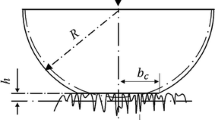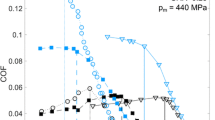Abstract
A line contact inlet zone analysis is carried out for the hydrodynamic lubrication in a fully plastic asperity contact. A governing equation of the central film thickness i.e. the film thickness in the fully plastic contact area is derived. An equation predicting this film thickness is also derived. It is found that for the fully plastic contact, under relatively light loads the prediction accuracy for the central film thickness is good, while at the load heavy enough the prediction equation greatly overestimates the central film thickness and the central film thickness solved from the analytical governing equation is significantly low showing the asperity in boundary layer lubrication. For the fully plastic contact, the central film thickness is nearly half of that obtained based on the elastic contact assumption for relatively light loads or even lower for heavier loads. The hydrodynamic lubrication is found difficult to form in the fully plastic asperity contact for the carried load heavy enough or the significantly low sliding speed between the asperities. To achieve a high hydrodynamic lubrication film thickness in the fully plastic asperity contact it is recommended to employ a high sliding speed or a high fluid viscosity. However, in the fully plastic asperity contact, the potential hydrodynamic load-carrying capacity is limited and much smaller than that based on the elastic contact assumption or predicted by conventional line contact elasto-hydrodynamic lubrication theory.
Similar content being viewed by others
References
Begelinger A., de Gee A.W.J.: On the mechanism of lubricant film failure in sliding concentrated steel contacts. ASME J. Lubr. Technol. 98, 575–579 (1976)
Zhang Y.B.: Contact-fluid interfacial shear strength and its critical importance in elastohydrodynamic lubrication. Industr. Lubr. Trib. 58, 4–14 (2006)
Jackson R.L., Green I.: A statistical model of elasto-plastic asperity contact between rough surfaces. Trib. Int. 39, 906–914 (2006)
Lin L.P., Lin J.F.: An elastoplastic microasperity contact model for metallic materials. ASME J. Trib. 127, 666–672 (2005)
Zhang Y.B.: Study of an engineering mixed contact: Part I-Theoretical analysis. J. Appl. Sci. 7, 1249–1259 (2007)
Zhang Y.B.: Study of an engineering mixed contact: Part II-Results for isosceles triangle surface ridges. J. Appl. Sci. 7, 1351–1361 (2007)
Zhang Y.B.: Study of an engineering mixed contact: Part III-Results for isosceles truncated triangle surface ridges. J. Appl. Sci. 7, 1467–1474 (2007)
Cioc C., Cioc S., Moraru L., Kahraman A., Keith T.G.: A deterministic elastohydrodynamic lubrication model of high-speed rotorcraft transmission components. Trib. Trans. 45, 556–562 (2002)
Johnson K.L.: Contact Mechanics. Cambridge University Press, Cambridge (1985)
Kogut L., Etsion I.: Elastic-plastic contact analysis of a sphere and a rigid flat. ASME J. Appl. Mech. 69, 657–662 (2002)
Kogut L., Etsion I.: A finite element based elastic-plastic model for the contact of rough surfaces. Trib. Trans. 46, 383–390 (2003)
Almqvist A., Sahlin F., Larsson R., Glavatskih S.: On the dry elasto-plastic contact of nominally flat surfaces. Trib. Int. 40, 574–579 (2007)
Jiang X., Hua D.Y., Cheng H.S., Ai X., Lee S.C.: A mixed elastohydrodynamic lubrication model with asperity contact. ASME J. Trib. 121, 481–491 (1999)
Shen D.W., Salant R.F.: A transient mixed lubrication model of a rotary lip seal with a rough shaft. Trib. Trans. 49, 621–634 (2006)
Dowson D., Higginson G.R.: Elastohydrodynamic Lubrication. Pergamon Press, Oxford (1966)
Pinkus O., Sternlicht B.: Theory of Hydrodynamic Lubrication. McGraw-Hill, New York (1961)
Barus C.: Isothermals, isopiestics and isometrics relative to viscosity. Am. J. Sci. 45, 87–93 (1893)
Grubin A.N.: Fundamentals of the hydrodynamic theory of lubrication of heavily loaded cylindrical surfaces. In: Ketova, Kh.F. (eds) Central Scientific Research Institute for Technology and Mechanical Engineering, pp. 115–166. D.S.I.R. London Translations, Wellington (1949)
Zhang Y.B., Wen S.Z.: An analysis of elastohydrodynamic lubrication with limiting shear stress: Part I-Theory and solutions. Trib. Trans. 45, 135–144 (2002)
Zhang, Y.B.: New film thickness equation for elastohydrodynamic lubrication of isothermal smooth line contacts under heavy loads for Newtonian fluids. Presented at the 2010 Amsterdam International Conference On Applied Mechanics
Wilson W.R.D.: Lubrication in metal forming. Trib. Ser. 30, 101–112 (1995)
Lo S.W., Wilson W.R.D.: A theoretical model of micro-pool lubrication in metal forming. ASME J. Trib. 121, 731–738 (1999)
Author information
Authors and Affiliations
Corresponding author
Additional information
Communicated by: Duck.
Rights and permissions
About this article
Cite this article
Zhang, Y. Hydrodynamic lubrication in fully plastic asperity contacts. Theor. Comput. Fluid Dyn. 26, 279–289 (2012). https://doi.org/10.1007/s00162-011-0228-8
Received:
Accepted:
Published:
Issue Date:
DOI: https://doi.org/10.1007/s00162-011-0228-8




